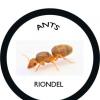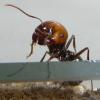I think they're Formica subsericea but i could be wrong.
1. Location of collection: Under a large brick. Next to a very large Lasius colony.
2. Date of collection: 7/31/16
3. Habitat of collection: Soggy woods. Heavy brush, not too much sun.
4. Length: 5~6mm Just an eyeball though. Don't have a unit of measurement off hand.
5. Coloration, hue, pattern and texture: All black, looks to have tiny hairs on gaster.
6. Distinguishing characteristics: 3 Queens, that's pretty distinguishing other then the other information i added.
7. Anything else distinctive : no
8. Nest description :Up flat against a large brick Some holes going down.. Prolly more queens, and a much larger colony down the holes.






















